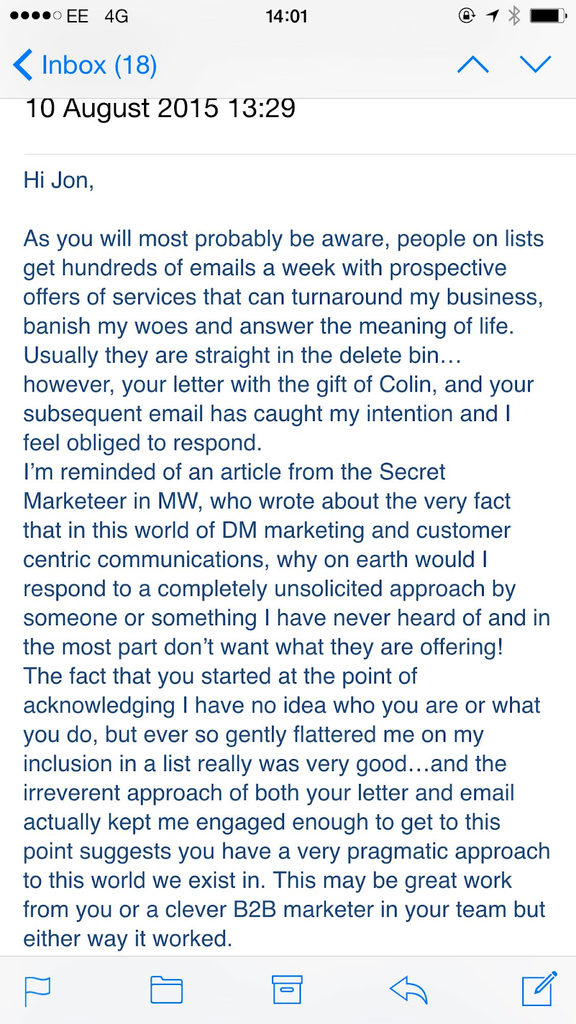How I write charming cold pitch copy
One of the things I have to think about when I wrote Charm Offensive templates is what I’ve called “The Way In.”
With the original drunk cold email, “The Way In” was to poke fun at the most obvious digital elephant in the room: the fact the prospect doesn’t know me – and I have no reason for my name to appear in their inbox – other than to fulfill my own commercial ambitions.
This is a point of potential tension. This potential tension provides an opportunity for humour, which not only breaks the tension but ingratiates you to recipients who enjoy the exciting taboo of occasionally smiling at work.
Imagine your bog-standard cold email, in all its glorious “not sounding like an email anyone would normally send ever” glory.
They immediately go to the pitch, forgetting the fact you’ve not dealt with the first concern the prospect has upon opening your email: Who are you? And what are you doing in my inbox?
I can understand why this is usually glossed over. Who wants to admit their email is an unsolicited pitch immediately? Surely, one should just pretend the elephant doesn’t exist, right? 😀
Another approach is to start with a question. Usually, a question phrased, again, in a way that one would utter outside of the context of a hypey-business email.
Perhaps it would like: <<cue awful cheesy 80s infomercial voice>> “Do you have trouble navigating the ever-changing world of social media?”
(Ughhhh. Shudder!)
Wow. No wonder people say cold pitching doesn’t work…
These approaches don’t deserve to work. It’s not the channel that’s to blame – it’s the content. What you deem as respectful, prospects deem as unoriginal, dull, and undeserving of even a sarcastic reply informing you of such.
In contrast, my original drunk cold email started with:
“Greetings {Firstname},
You’ve never heard of me. (Hi, I’m Jon.) I got your details from a list. *gasp!* But hey, at least you’re list-worthy, that’s gotta be worth something, right?”
This opening deals with the concern that the prospect likely (and rightly) has.
It may make them smirk.
Or smile.
Or even chuckle slightly to themselves.
The important bit: It gets a positive reaction. You only need a smirk to get a positive response. Boring emails don’t get smirks. Somewhat daring, creative, funny ones do.
I’m not suggesting the adformentioned opening few lines of my drunk cold email are anywhere close to “stand-up comedy funny” – they aren’t. But it doesn’t need to be – We’re not competing against comedians when sending these communications. We’re competing with other businesses. And the bar for good, human-like communications in the world of b2b communications is (let’s be charitable here) … low.
One of my prospects summed this up in their response to my charming advances. I’m glad I saved this one – as it has become useful in explaining this concept to folks.

I’ve used the “Stranger In Their Inbox” opener and variations of it for many of the cold email templates I’ve written. This changed when I wrote The Charming Cold Open Template Pack earlier this year. I decided to write templates that used none of the devices and lines or variations of lines I’d used up until that point.
And yes, those templates also work:

I’m in the process of writing a new template pack – The Charming Black Friday and Cyber Monday Template Pack. This pack contains cold pitch (cold email or LinkedIn being the most obvious channels) for freelancers, agencies, and other b2b suppliers to generate leads – by taking advantage of the upcoming sales extravaganza that is Black Friday weekend.
You might think this is a peculiar move. Surely Black Friday and Cyber Monday are the concern of companies selling to consumers, not us plying our wares in the stuffy BORING-2-BORING sector?
That’s the genius of it. There’s a potential point of tension there. Prospects will no doubt have this same moment as they read your email, “Huh? Why is a marketer/designer/copywriter/developer/designer/consultant/coach sending me a Black Friday email?”
And that’s great – curiosity gets people to read on – and then they will do one of the following things:
- Read it and choose to do nothing. They will ignore you – and your follow up attempts. Either because the email/message didn’t excite them – or they have no interest whatsoever in what you have to offer. You can’t win them all, I’m afraid. (Don’t worry, this list gets better!)
- Think “Ahaha. Ok. That’s amusing. I see what they did there.” and maybe even hit reply, informing you that they enjoyed your amusing email – before informing you that “now isn’t the right time.” or “I don’t need a marketer/designer/copywriter/designer/consultant/coach.”
- Think “Ahaha. Ok. That’s amusing. I see what they did there.” and maybe even hit the reply button – but, alas, then they get distracted and never hit send. RATS!
- Think “Hahahahahaha! FINALLY – Someone sending something that doesn’t sound like it has been spat out of a the most boring robot ever!” and hit reply, informing you that they enjoyed your amusing email – before asking, “When are you free to do a quick call?” or “Who am I to turn down an offer of free ideas? What information do you need from me?” – DING! DING! DING!
- Think “THIS CREATIVE EMAIL CONFUSES ME. I AM AN ANGRY PERSON! AND VERY IMPORTANT!! ! !” before replying with something like, “You should be more professional!!!!!11 You’ll never amount to anything with this approach. Trust me. P.S. I’m VERY IMPORTANT, don’t you know?!”
Ok… I’ve had a bit of poetic license with the last one…
It’s completely inaccurate, I’ll admit it. You know it, and I know it: Such self-important, foamy-mouth prospects would never respond with anything that honest and self-aware. 😀
Thankfully, category 5) contains by far the least amount of people – and because they’ve revealed themselves to be tosspots – you can feel happy in the knowledge you’re never going to have to speak to them ever again. BONUS!
There’s not much we can do about 1) However, as they’ve not replied, this requires you to do nothing. Woohoo!
For 2) You should respond, thanking them for their kind words and asking them if you may email/message them in 3 or 6 months to see if anything has changed.
For 3) Make sure you send follow-up messages. If you’re sending a lot of emails, you should automate this process with software. This will give you another opportunity to get the attention of any hectic prospects who enjoyed your opening gambit – but got distracted with other work tasks. (How dare they, am I right? :D)
For 4) Respond and thank them for their kind words – and then try to get them on a call – which based on their gushing response, they should be up for. Many of them will even specifically suggest scheduling a phone call in their response. Don’t think you have to continue the irreverent tone of your opening gambit any further. I never did. Good lord – can you imagine how annoying that would be? Instead, show your enthusiasm – and demonstrate your knowledge. You’ve already made a great first impression. The prospect wants to talk to you. Now it’s on you to show them your offering is worth their time and money.

